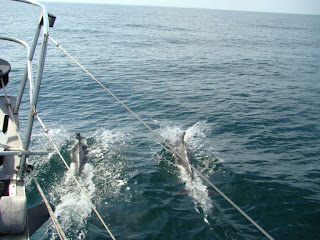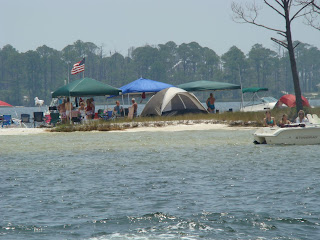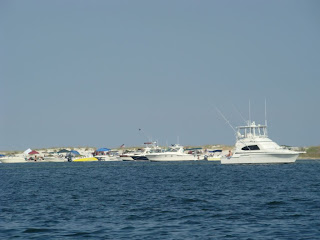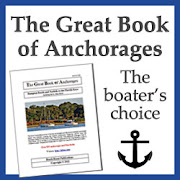
Even after 16 years of cruising we still find we get the pre-departure anxieties just before and as we shove off after a long spell at the dock. You start to worry about the weather, and what if the boat breaks down and what if the anchor breaks loose in the middle of the night and what if the mast falls down and on and on. You finally have to force your self to stop thinking negative thoughts and concentrate on all of the positives you know you will encounter. You tell yourself that you have done this all before and you can handle anything that comes along.
We finally got off the dock on Sunday albeit a bit late. We usually try to get a very early start but this time we still had a little prep to do so we did not untie the dock lines till 10 AM. The folks we had come to know during our two year stay were on hand to shove us off and we receive a horn salute as we pulled out of the slip. A Cape Dory club race was scheduled that morning so we had lots of company. A short trip to the fuel dock and topping off the fuel tank and deck jugs was our final chore.
Fuel at 3 Amigos was $4.19 a gallon for diesel, ouch, and we knew this was just a preview of things to come. As we left Clear Lake and exited the entrance channel we had several farewells over the VHF radio. We were surprise that no one ask us what we were doing going in circles to do a calibration of the autopilot. Soon we were heading down Galveston Bay. As usual the ship and barge traffic were pretty heavy even for a Sunday. It was a bright sunny day so lots of folks were out on the water.
Now you will probably get tired of reading in these posts as we go along, some of my rants about the weather service, but we have been doing this for a long time and have some pretty strong opinions. Now I know forecasting weather is not an exact science but with billions of dollars worth of computers and satellites and degrees in meteorology you would think that once in a while they would get it right. We delayed leaving for a day or two because the winds have been quite strong from the direction
we needed to go and Galveston Bay is no fun in those conditions. For a couple of days all of the forecasts called for NE winds 10 to 15 on Sunday going east at 10 to 15 Sunday afternoon. A perfect run down the bay and no motoring while using that expensive diesel. As we left Clear Lake it was indeed NE but very light, maybe 5 to 8. Very shortly as we entered and headed down the ship channel it turned to the SE, the exact direction we needed to go, and as the day progressed built to 15 to 20, yes, right on the nose. Typical NWS forecasting or lack there of, and we should know better after all these years. For some reason they just can not get marine forecasts right. We have observed this over a 16 year period so this is not just based on this forecast. With the millions and millions this agency spends and the equipment at their disposal you would think they could get it right once in a while. Our forecast for today, Monday, was SE 10 to 15 for the area we are in. I can tell you we indeed have
had 10 to 15 then 15 to 25 with gusts to 30 except out of the NE. Oh, by the way, that is the direction we are heading, but at least we are in the protection of the Gulf ICWW. Now the forecast for today, Monday, is for a 20% chance of rain and mostly north of the Houston area and we are about 70 miles south. Temps are suppose to be 78 to 80 degrees and mostly cloudy. It has been pouring rain to the point that we have had zero visibility at times and there appears little sign it will quit today and
the temps are in the 60s. I am still not sure why they don't call it weather guessing instead of forecasting. So much for the weather rant.
We arrived at our planned anchorage behind Baffle Point off the Bolivar Peninsula around 3:30 PM Sunday afternoon. The winds were still pretty much SE so we had fairly good protection even though we could not get close to shore with our 6 foot draft. But all in all it was a pretty good spot. This is a fair weather anchorage only since the entire bay is exposed from the north and a north wind would not be fun. We spent a peaceful night although the first night at anchor we are still getting used to
new sounds not heard at the dock and a few times during the night we were visited by some strange swells from unknown sources that really rocked us from side to side. Fortunately it was not often and did not last long. The wind stayed out of the SE all night and was down to about 5 knots by morning.
We were up at the crack of dawn Monday because we had a long 55 miles to our next anchorage. We have a regular routine each morning while under way. First the engine gets a thorough check, oil, transmission fluid, water and a good look over for leaks and any other issues. All of this info is recorded in our log book. Next we check the levels of the fuel and water tanks, the battery status, bilge and bilge pumps and engine hours from the previous day, recording all information good or bad. Next is breakfast and the most important thing, coffee. We check that all electronics and radios are working and get things on deck ready including any sails we plan to use during the day. This is done daily without exception and we use a check list to make certain nothing is over looked. So by 7:40 AM we had the anchor up and were under way. Did I mention I LOVE, LOVE our new electric windlass. After 15 years of cranking that anchor and chain up with a manual windlass this was a real treat. I even had to make note of this in the log book. At 08:00 AM sharp we entered the Gulf ICWW for our looonnnnggg trip on the Gulf coast. Once again we found the waterway busy with tugs and barges.
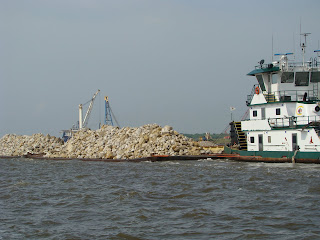
So it pretty much rained and blew all day. We put down the side curtains for the cockpit which makes a complete enclosure and stayed dry at least. Tug and barge traffic was pretty heavy but with the new AIS receiver running on our chartplotter we were easily able to keep track of everyone. Having the plotter at the helm was a real treat after running our navigation program from the computer at the nav station. By 6:20 in the afternoon our anchor was down in Taylor Bayou just west of Port Arthur Texas. The weather has settled down a bit but we can't be sure how long it will hold. The anchorage is very protected and secure but very remote. We have had dinner and settled in for the night and just kicking back and watching TV. Tomorrow will be another early start to get to our next anchorage before some heavy winds that are forecast, HA HA.
 We honestly believe the folks at the National Weather Service have totally lost it. Every day the forecast changed 3 or 4 times a day and the next day it changed 3 or 4 times a day. We could not make heads or tails of what we could expect offshore. Our plan was to move down to near the Pensacola Ship Channel on Wednesday and head out into the Gulf on Thursday morning. Because of 48 and 50 foot fixed bridges over the waterway on the east side of Pensacola, we had to go out into the Gulf at this point. On Wednesday morning the forecast had changed from the 4AM forecast to the 10AM forecast and again made no sense. So we made the decision to just leave the marina and go and just see what we had. Of course our actual conditions differed totally from the NWS forecast but we figured that at some point in the last few days they must have forecast these conditions.
We honestly believe the folks at the National Weather Service have totally lost it. Every day the forecast changed 3 or 4 times a day and the next day it changed 3 or 4 times a day. We could not make heads or tails of what we could expect offshore. Our plan was to move down to near the Pensacola Ship Channel on Wednesday and head out into the Gulf on Thursday morning. Because of 48 and 50 foot fixed bridges over the waterway on the east side of Pensacola, we had to go out into the Gulf at this point. On Wednesday morning the forecast had changed from the 4AM forecast to the 10AM forecast and again made no sense. So we made the decision to just leave the marina and go and just see what we had. Of course our actual conditions differed totally from the NWS forecast but we figured that at some point in the last few days they must have forecast these conditions. 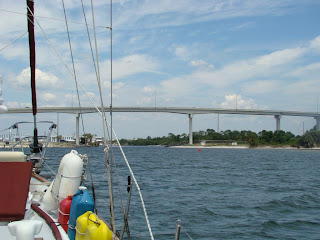 Around 3PM we were secured at the dock and getting the boat out of offshore mode. We stow things a lot better and put everything away off the decks when offshore but not necessarily so secure when we are running the inside of the waterway. Our plan is to do short 15 to 20 mile runs for the next few day, then stage ourselves to run offshore again from Carrabelle to the Florida Barge Canal near the Withlacochee River. We will spend a couple of days there visiting friends and relatives.
Around 3PM we were secured at the dock and getting the boat out of offshore mode. We stow things a lot better and put everything away off the decks when offshore but not necessarily so secure when we are running the inside of the waterway. Our plan is to do short 15 to 20 mile runs for the next few day, then stage ourselves to run offshore again from Carrabelle to the Florida Barge Canal near the Withlacochee River. We will spend a couple of days there visiting friends and relatives.
